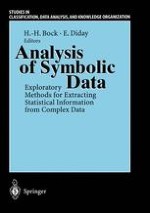Raymond Bisdorff CRP-GL, Luxembourg The development of the SODAS software based on symbolic data analysis was extensively described in the previous chapters of this book. It was accompanied by a series of benchmark activities involving some official statistical institutes throughout Europe. Partners in these benchmark activities were the National Statistical Institute (INE) of Portugal, the Instituto Vasco de Estadistica Euskal (EUSTAT) from Spain, the Office For National Statistics (ONS) from the United Kingdom, the Inspection Generale de la Securite Sociale (IGSS) from Luxembourg 1 and marginally the University of Athens . The principal goal of these benchmark activities was to demonstrate the usefulness of symbolic data analysis for practical statistical exploitation and analysis of official statistical data. This chapter aims to report briefly on these activities by presenting some signifi cant insights into practical results obtained by the benchmark partners in using the SODAS software package as described in chapter 14 below.
